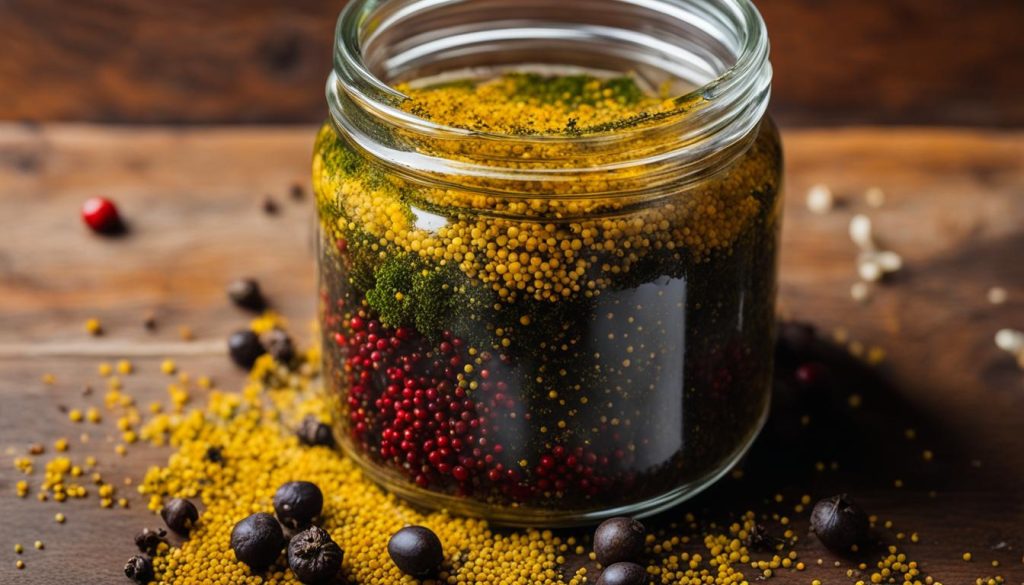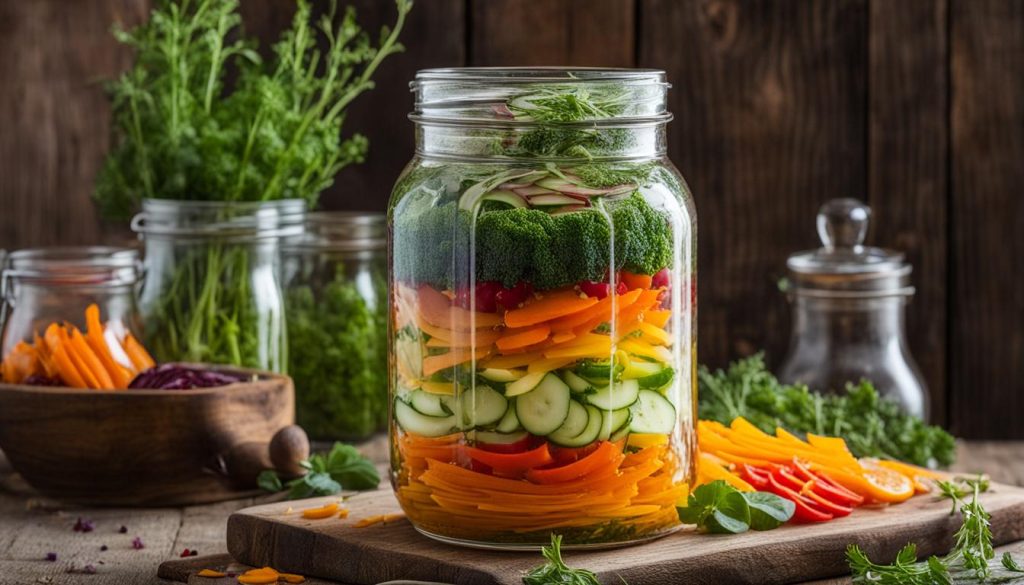Home pickling is a fantastic way to preserve the freshness of your favorite vegetables and enhance their flavors. With the right pickling brine, canning jars, and vinegar solutions, you can ensure safe and long-term storage of your pickled vegetables. In this article, we will delve into the art of home pickling, exploring different pickling methods, flavor enhancement techniques, and tips for ensuring food safety during the pickling process.
Key Takeaways:
- Home pickling can significantly extend the shelf life of vegetables, ensuring you can enjoy them for up to a year.
- Pickling brine, made from vinegar, salt, water, sugar, and spices, is crucial for preserving vegetables through home pickling.
- The choice of vinegar and spices can greatly impact the flavor profile of your pickled vegetables.
- Proper food safety measures, such as washing vegetables and sterilizing canning jars, are essential to ensure the safety of your pickled vegetables.
- Storing pickled vegetables in a cool, dark place is key for long-term storage and maintaining their quality.
The Basics of Home Pickling
Home pickling is a popular method of preserving vegetables and adding a burst of flavor to your meals. By using a pickling brine made from vinegar, water, salt, sugar, and a variety of spices, you can transform fresh vegetables into delicious pickles that can be enjoyed throughout the year. So, how exactly does home pickling work?
First, you’ll need canning jars to hold your pickles. These jars ensure proper sealing and long-term storage of the pickled vegetables. Once you have your jars ready, you can start preparing the pickling brine. This brine is the key ingredient that gives pickles their distinctive tangy flavor.
The pickling brine is typically made by combining vinegar, water, salt, sugar, and a selection of spices. The vinegar acts as a natural preservative, while the salt helps to draw out moisture from the vegetables and enhance their crispness. The sugar balances the acidity of the vinegar and adds a touch of sweetness to the pickles. As for the spices, they play a crucial role in infusing the pickles with unique flavors.
Common spices used in pickling include mustard seeds, dill seeds, coriander seeds, and black peppercorns. These spices can be adjusted according to your taste preferences. Additionally, fresh herbs like dill, basil, or cilantro can be added to provide an extra layer of aroma and complexity to the pickles.
Once you have prepared the pickling brine, it’s time to pack the vegetables into the canning jars. Make sure to wash and dry the vegetables thoroughly before packing them. You can choose to slice, dice, or leave the vegetables whole, depending on your preference.
After packing the vegetables into the jars, carefully pour the prepared pickling brine over them, ensuring that all the vegetables are completely submerged. This step is crucial to ensure proper pickling and preservation of the vegetables. Seal the jars tightly to prevent any air or contaminants from entering.
Now that you have your jars filled with vegetables and pickling brine, you’ll need to store them in a cool, dark place. The pickles will need time to develop their flavors, and this can take anywhere from a few days to a few weeks, depending on the desired level of acidity and crunchiness.
Once the pickles have reached your desired taste and texture, they are ready to be enjoyed! You can serve them as a side dish, add them to sandwiches or salads, or simply enjoy them as a snack. Homemade pickles made through the home pickling method offer a fresh and flavorful alternative to store-bought pickles.
Now that you understand the basics of home pickling, you can start experimenting with different vegetables, flavor combinations, and pickling techniques to create your own unique pickles. In the next section, we will explore some popular vegetables that are perfect for home pickling.
Popular Vegetables for Home Pickling
When it comes to home pickling, a wide range of vegetables can be preserved. Some popular vegetables for pickling include cucumbers, green beans, asparagus, carrots, beets, radishes, onions, peppers, zucchini, and summer squash. These vegetables offer a colorful and flavorful variety that can elevate any dish.
Whether you prefer tangy pickled cucumbers in your sandwiches or spicy pickled peppers to add a kick to your salads, there is a pickled vegetable for every taste. The process of pickling enhances the natural crunchiness of these vegetables, creating a delightful contrast in texture and flavor.
You can slice cucumbers into rounds or spears, preserving their refreshing taste. Green beans and asparagus can be pickled whole or cut into shorter lengths, offering a satisfying crunch. Carrots, beets, radishes, and onions can be sliced or diced, adding a vibrant splash of color to your pickled vegetable medley. Peppers, whether sweet or spicy, can be pickled whole or sliced, releasing their unique punch of flavor. Zucchini and summer squash can be sliced into coins or spears, providing a tender and succulent texture.
The beauty of home pickling is the freedom to experiment with different combinations of vegetables and flavors. You can create a signature blend of pickled vegetables that complements your favorite dishes and adds a burst of freshness to your meals.
Whether you serve them as a side dish, use them as a topping, or enjoy them straight from the jar, these pickled vegetables are a versatile addition to your culinary repertoire. Their tangy, sweet, and savory profiles make them an excellent accompaniment to sandwiches, burgers, tacos, salads, charcuterie boards, and more.
Don’t limit yourself to store-bought pickles when you can create your own flavorful creations at home. With the right combination of vegetables, spices, and pickling brine, you can embark on a culinary adventure that will impress your friends and family.
Here are some ideas for using pickled vegetables:
- Add pickled cucumbers to a classic tuna or chicken salad for a tangy twist.
- Top your favorite tacos or nachos with pickled onions for a burst of flavor.
- Layer pickled beets on a burger for a colorful and tasty addition.
- Garnish a Bloody Mary with pickled asparagus for a zesty kick.
- Toss pickled radishes into a refreshing summer salad for an extra crunch.
As you delve into the world of home pickling, don’t be afraid to get creative and try different combinations of vegetables and flavors. Let your taste buds guide you, and soon you’ll have a selection of pickled vegetables that will elevate your culinary creations to new heights.
Pickling Liquid and Spices
In the art of home pickling, the pickling liquid plays a vital role in infusing flavor and preserving the vegetables. The pickling liquid is a combination of vinegar, water, salt, and sugar.
Vinegar provides the necessary acidity to the brine, creating an environment that inhibits the growth of harmful bacteria while enhancing the taste of the vegetables. Common types of vinegar used for pickling include white vinegar, apple cider vinegar, and white wine vinegar.
Water acts as a diluent for the vinegar, ensuring that the brine is not too acidic. It helps to balance the flavors and prevent the pickled vegetables from becoming overly sour.
Salt is crucial for the preservation of the vegetables. It draws out moisture from the vegetables, creating an environment in which bacteria cannot thrive. Additionally, salt enhances the overall taste and texture of the pickles.
Sugar is added to the pickling liquid to balance out the acidity of the vinegar. It adds a subtle sweetness that complements the tanginess of the brine, creating a harmonious flavor profile.
To elevate the flavor of the pickled vegetables, a variety of pickling spices can be added to the brine. These include coriander seeds, fennel seeds, mustard seeds, black peppercorns, and dill seeds. These spices add complexity and depth to the pickles, enhancing their overall taste.
In addition to pickling spices, aromatic ingredients like garlic, onion, and fresh herbs such as dill, cilantro, basil, and parsley can be included in the pickling liquid. These ingredients impart enticing aromas and flavors to the pickles, making them more enjoyable.
The combination of vinegar, water, salt, sugar, pickling spices, garlic, onion, and fresh herbs creates a brine that not only preserves the vegetables but also enhances their taste, aroma, and texture. Experimenting with different combinations of these ingredients can lead to a wide array of unique and delicious pickled vegetables.
How to Pickle Vegetables at Home
The process of home pickling begins with washing and preparing the vegetables of your choice. Whether you prefer them sliced, diced, or left whole, the key is to ensure they are fresh and ready for pickling.
Next, it’s time to layer the vegetables in mason jars, along with your desired pickling spices, garlic, onion, and fresh herbs. This layering process helps distribute the flavors evenly throughout the jar, resulting in deliciously infused pickled vegetables.
While you’re layering the vegetables, it’s crucial to heat the pickling liquid on the stove until it reaches a gentle boil. The pickling liquid typically consists of a mixture of vinegar, water, salt, and sugar. This combination provides the necessary acidity, preservation, and balance of flavors for your pickles.
Once the pickling liquid is boiling, carefully pour it over the layered vegetables in the mason jars, ensuring they are fully submerged. This step is crucial to guarantee the pickling process occurs evenly and thoroughly.
After pouring the hot pickling liquid, allow the jars to cool on the counter before covering them and placing them in the refrigerator. It’s recommended to refrigerate the pickles for approximately 12-24 hours, allowing them to develop their flavors and achieve the desired level of tanginess.
Once chilled, your homemade pickled vegetables are ready to be enjoyed! They can be stored in the refrigerator for up to 2 weeks, and make a delightful addition to salads, sandwiches, charcuterie boards, or served as a tangy side dish.
For more detailed guidance on getting crisp home-pickled vegetables, you can refer to the USU Extension’s research. They provide valuable insights and tips to help you achieve perfectly crisp and flavorful pickles.
Tips for Successful Home Pickling
To ensure successful home pickling, it’s important to follow a few tips. First, use fresh and high-quality vegetables for the best flavor and texture. Select vegetables that are firm, ripe, and free from blemishes or signs of spoilage. This will ensure that your pickled vegetables turn out delicious and satisfying.
Second, experiment with different pickling spices and herbs to create unique flavor combinations. Adding spices such as dill seeds, mustard seeds, and black peppercorns can enhance the taste of your pickles. Fresh herbs like dill, cilantro, basil, and parsley can add a fragrant aroma to the pickling brine, creating a delightful sensory experience.
Third, practice proper food safety measures to prevent any contamination. Before pickling, make sure to wash the vegetables thoroughly under running water to remove any dirt or pesticide residue. Also, sterilize the canning jars and lids by boiling them for a few minutes or running them through a dishwasher cycle. This will ensure that your pickles are safe to consume and free from any harmful bacteria.
Finally, store the pickled vegetables in a cool and dark place for long-term storage. The ideal temperature for pickles is between 40-50°F (4-10°C). You can store them in a pantry, basement, or refrigerator, depending on the desired texture and flavor. Make sure that the jars are properly sealed to prevent any air or moisture from entering, which can cause spoilage.
Following these tips will help you achieve successful home pickling, allowing you to enjoy the flavors of your favorite vegetables all year round.
Tips for Successful Home Pickling
| Tips | Details |
|---|---|
| Use fresh and high-quality vegetables | Select firm, ripe vegetables without blemishes or signs of spoilage |
| Experiment with pickling spices and herbs | Add flavors like dill seeds, mustard seeds, and fresh herbs |
| Practice proper food safety measures | Wash vegetables thoroughly and sterilize canning jars |
| Store pickled vegetables properly | Keep them in a cool and dark place with properly sealed jars |
Conclusion
Home pickling is a rewarding and flavorful way to preserve your favorite vegetables. With the right pickling brine, canning jars, and spices, you can unlock the flavors of your vegetables and enjoy their freshness even after the harvest season. By following the proper pickling process and practicing food safety measures, you can ensure the longevity of your pickled vegetables and savor them throughout the year.
Experiment with different combinations of vegetables and spices to create unique pickles that will delight your taste buds. Whether you prefer tangy dill pickles or spicy pickled peppers, home pickling allows you to customize the flavors to your liking. The pickling process not only enhances the taste of the vegetables but also preserves their texture and nutritional value.
From pickled cucumbers to pickled beets, home pickling offers a wide range of possibilities for vegetable preservation. With the right techniques and ingredients, you can enjoy the flavors of summer all year round. So, roll up your sleeves, gather your favorite vegetables, and embark on a delicious home pickling adventure!


